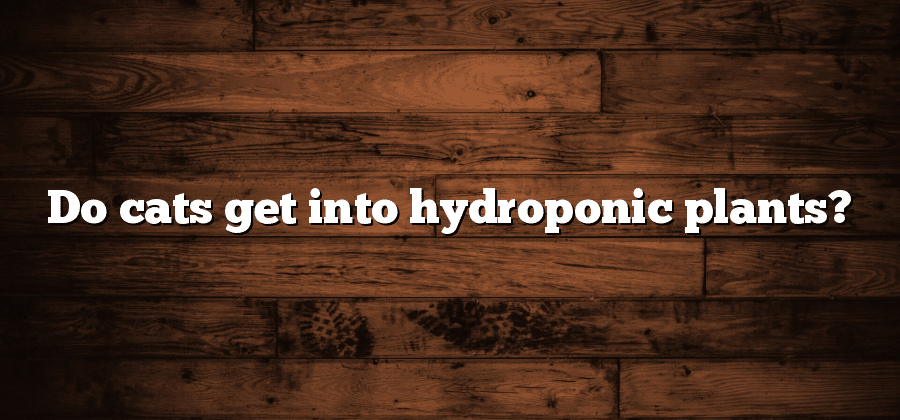Potential Hazards of Hydroponic Plants for Cats
Hydroponic plants, also known as soilless plants, have gained popularity among indoor gardeners and plant enthusiasts. However, as cat owners embark on their hydroponic plant journey, it is important to be aware of the potential hazards these plants pose to our feline companions. Cats are natural explorers and curious creatures, making them susceptible to interacting with hydroponic plants in various ways.
One of the main hazards is the risk of ingestion. Cats have a tendency to nibble on plants, and some hydroponic plants may be toxic to them. Certain plant species used in hydroponics, such as lilies, aloe vera, and philodendrons, can cause severe health issues if ingested by cats. From gastrointestinal problems to kidney damage, the consequences of such interactions can be life-threatening for our beloved feline friends. Thus, it is essential to educate ourselves about the specific plants we choose for our hydroponic endeavors and ensure they are safe for our cats to be around.
Understanding Cats’ Curiosity and Exploration Behavior
Cats possess an innate sense of curiosity and exploration, which often leads them to investigate their surroundings and conquer new territories. This behavior stems from their predatory instincts and sharp sensory abilities. Felines are known for their acute hearing, exceptional night vision, and keen sense of smell, enabling them to navigate their environment with precision and grace. As natural hunters, they are driven by a strong desire to hunt, stalk, and pounce on potential prey, even in a domestic setting. This inherent curiosity makes them exceptionally curious about any new objects or plants that appear within their territory, including hydroponic plants.
When it comes to hydroponic plants, cats are particularly intrigued by their lush foliage and vibrant colors. The unique growing methods and absence of soil can make these plants seem like appealing playthings to our feline companions. They may be enticed by the dangling leaves or the delicate tendrils, and find joy in swatting or batting at them. Additionally, the presence of running water in hydroponic systems intrigues cats, as they are naturally drawn to the sound and movement. This combination of visual and auditory stimuli makes these plants all the more captivating to our curious feline friends.
The Attraction of Hydroponic Plants to Cats
Hydroponic plants offer a unique appeal to cats, drawing them in with their vibrant colors and lush foliage. Cats are naturally attracted to vegetation, and the sight of these thriving plants can trigger their curiosity and exploration behavior. The scent and texture of the leaves further entice cats to investigate and interact with the plants.
The allure of hydroponic plants lies not only in their visual and olfactory stimuli but also in their accessibility to cats. These plants are often grown indoors, making them easily accessible to feline companions. Their proximity to living spaces, such as windowsills or shelves, makes it convenient for cats to reach out and engage with the foliage. This accessibility, coupled with cats’ innate desire to explore their surroundings, makes hydroponic plants an irresistible source of fascination for our feline friends.
Identifying Common Signs of Cat Interaction with Hydroponic Plants
Hydroponic plants can be a tempting source of curiosity for cats, and their interaction with these plants can often result in noticeable signs. One common sign of cat interaction with hydroponic plants is the presence of knocked over or displaced pots. Cats are naturally inquisitive animals, and they may be drawn to the lush foliage and unique growing environment of hydroponic plants. As they explore, they can accidentally tip over pots or even knock them off shelves or tables in their attempts to get a closer look.
Another sign to look out for is bite marks on the leaves or stems of the hydroponic plants. Cats have a natural instinct to gnaw on plants as a way to investigate their surroundings or even for entertainment. If you notice small puncture marks or frayed edges on the leaves or stems of your hydroponic plants, it is a strong indication that your cat has been interacting with them. These bite marks can not only damage the plants but also pose a potential health risk for the cat if they ingest any toxic or harmful parts of the plant.
Preventive Measures to Keep Cats Away from Hydroponic Plants
One of the primary concerns when it comes to hydroponic plants and cats is ensuring the safety of our feline friends. Cats are naturally curious creatures, and the sight of lush green foliage can be incredibly enticing for them. However, it is important to remember that not all plants are safe for cats to interact with, and certain preventive measures can be taken to protect both the plants and our furry companions.
One effective way to keep cats away from hydroponic plants is to create a physical barrier between them. This can be done by placing the plants in an area that is inaccessible to cats, such as a dedicated room or a high shelf. Using tall plant stands or hanging baskets can also help keep the plants out of reach. Additionally, investing in plant netting or wire mesh can add an extra layer of protection, preventing cats from getting too close to the plants.






